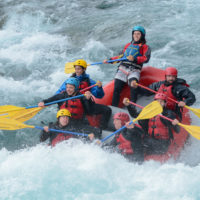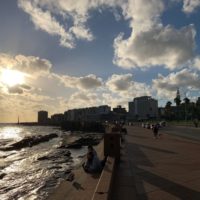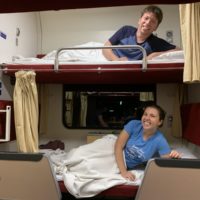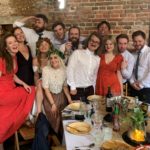This blog is fifteen years’ old today! Which means, since I am almost-but-not-quite 30, that I have now been blogging for over half of my entire life. (I’m not sure if that’s a cause for celebration or just slightly frightening.) It also means that my blog has now entered a new phase of child development with “a deeper capacity for caring and sharing” and “more concern about future school and work plans”. So in the spirit of caring and sharing, here are a few Easter highlights since arriving back in London last week.

We were very lucky to be able to time our return to just catch Randi’s school friend Melissa while she was still visiting the UK. She wanted to visit Brighton and so we caught the train down for a day trip on Easter Friday, Randi and I both armed with shiny new Railcards which – given the amount of travelling around the UK we’re planning to do – are going to pay off very quickly. We took in all the kitsch of the pier before Randi led us in the direction of Brighton’s “best fish and chips” where she got more fish than she was bargaining for. Later we relaxed in the gardens of the Royal Pavilion. I’ve been to Brighton a couple of times before but didn’t remember how nice these gardens were, helped by the amazing sunshine and enlivened by the bloke wandering up and down trying to sell bird whistles with a practical demonstration.

That night we arrived back at my family home for one of the least convincing Passover Seder nights ever put on by any group of people. I’m still not entirely clear why this happened and Randi was deeply sceptical at the challah bread and salted caramel brownies, but whatever it was it was a lot of fun. One of my favourite absurdities was when I successfully found the afikoman and discovered that it came with a box of Easter eggs.

We also took Melissa to Hampstead Heath (lovely as always) and Camden Market (surely a bad location for climate change protests since the crowd was already so heaving it was hardly noticeable) before she left for Paris, and on Sunday night we moved on to visit Joshua in his new flat in the far-away lands of Kingsbury. I can already tell that moving back to London with Randi is going to inspire me to discover whole new areas of London and I was amazed to discover that a quaint country village – complete with quiet, windy roads – has been nestling a couple of stops up the Jubilee line this whole time. We admired Josh’s huge garden, gobbled up dinner, shared some wine and then fell asleep in his spare bedroom.
While Josh and I have always stayed in touch, I haven’t seen Rishal since… well, maybe 2011 (when he last showed up in this blog) and certainly not since I moved to Chicago. So it was incredibly wonderful to hang out in Willesden’s Beer & Burger (they didn’t have this in my day) and catch up over many years of life developments. Afterwards I walked back to his parents’ house with the hopes of seeing them again, and was rewarded not only with their company but also a large bag of assorted McVitie’s products… just like the old days, when his dad worked for them and would always have boxes of biscuits lying around.
Finally, Randi and I spent a night admiring Tash’s enviable new flat in Shepherd’s Bush over falafel and wine. We’re not actively looking for a permanent home yet, but anywhere we go is being closely assessed for its parks, buses and takeaways…
I’m sitting in my aunt’s kitchen, snacking on Quavers and celebrating mundane achievements like acquiring a new debit card (after leaving my old one somewhere in Cambodia) and having the following conversation with T-Mobile:
“Hi, I’d like to cancel my T-Mobile account as I’ve left the country.”
“Sure, I can help with that. If you’re planning to come back I can just pause your bill.”
“No, it’s OK, I’ve left for the foreseeable future. [awkward pause] I mean, I’m not barred from the country or anything…”
“OK, OK, got it. So I can go ahead and cancel, but just to warn you that your SIM card will stop working immediately.”
“That’s fine. My SIM card is currently in the possession of a Peruvian teenager who stole it from me on a crowded bus in Lima so… it’ll be his problem.”
But before my brain is completely swamped by a reintroduction to London, I wanted to close out our four-and-a-bit months of travelling with some general bits and bobs from our big journey across South America and Southeast Asia.
An obvious question to ask is “what was the best part?” and for overall sense of achievement it’s difficult to argue with the W Trek in Torres del Paine National Park, Chile. It’s obviously easier to hop on a tour but nothing compares to the satisfaction of carrying your tent, clothes and food along on your back for five days, even if it wasn’t always enjoyable at the time…

Interactive Destination Map

20 Different Transport Modes
Aeroplane, car, bus, coach, train, bicycle, minivan, tuk-tuk, motor boat, catamaran, ferry, kayak, basket boat, dragon boat, slow boat, subway, metro, cable car, pick-up truck, feet.
Four Extreme Photos
If GPS is to be believed, here is the furthest north, east, south and west that we went and snapped a photo. (Fair warning: furthest north is particularly unimpressive.)
Concept stolen from DG. Disclaimer: some photos may lack proper GPS co-ordinates blah blah blah. I did my best.
Public Transport Smartcard Nerd-a-thon
I ended up with six different cards in total. Bangkok’s Rabbit card is the clear winner in terms of cute design, but the downside is that it only covers one of the city’s three rail systems and none of the buses. Singapore was the only place organised enough to sell three-day tourist passes at our port of entry, while Kuala Lumpur loses many, many points for charging a ‘reloading fee’ every time you want to add more value onto your card. Not cool.

47 Accommodations
By default we stayed in AirBnbs, with a mix of the “staying in someone’s back room” type which Catherine and AJ find so awkward to whole apartments and repurposed hotel rooms. On top of that we also slept in a couple of hostels, four sleeper trains and one tent. Our most ritzy accommodation was definitely Marina Bay Sands in Singapore and for extreme relaxation it has to be the Ten Moons Resort in Koh Lipe.
Special shout-outs to Mary in George Town who kept insisting that everything was better in the Philippines and to Sophie in Laos who nonchalantly told us her crazy stories about babysitting pumas in the Bolivian jungle and bare-metal 48 hour bus rides. Apologies to the man in Puerto Natales who we tried to evict from a room that was rightfully his. And we will try to forget about the family who played acoustic guitar together outside our bedroom at 3am before – for some reason – poking their heads in our room.

The “watch a Disney film on the plane” tradition
My flight home Disney entertainment was Ralph Breaks the Internet, a gleefully self-referential sequel to Wreck-It Ralph which still manages to tell a decent story but is basically wasted on children who are not going to appreciate any of the best jokes. Highly recommended for your next flight, and be sure to stay through the end credits.
One moody black-and-white photo from Angkor Wat

Full Index of Blog Posts
13th April 2562, Bangkok.
The night before we had acquired our arms from a nearby dealer. It was a necessary act of self-defence to protect ourselves from trouble but also signalled our own commitment to fight, and we familiarised ourselves with our new weapons with a hastily arranged target practice back at base. This was not enough to protect me from a first strike the next morning on neutral ground – a victim of some ill-disciplined young fighters who found excitement in an unprovoked attack – but the majority of the battle was confined to designated combat areas other than some stray shots from passing vehicles. Some, like us, came from abroad but the majority appeared to be locals who had been looking forward to the scrap for some time. They expected the fighting to last for three days.
We arrived at the scene, suitably uniformed, to a war of all against all – but the majority of us formed a slow procession, not a scrum, as we marched along the road. At unpredictable moments the crowd would break into a roar, in a surge of emotion, or descend on a single victim with the passion of the mob. But much of the battle was marked by remarkable self-discipline fuelled by a shortage of ammunition. Profiteers enriched themselves by selling extra rounds by the side of the road, although they remained vulnerable to attack themselves and were frequently hit. Only the police seemed immune to fire, guarding the site but doing nothing to prevent the carnage before them. I regret to say that my weapon was no match for better-armed opponents who fired with more powerful guns, and I came away thoroughly vanquished but proud of the small part I had played.
I had a great time at Songkran.



Joking aside, Bangkok’s multi-day New Year celebrations (based on the Buddhist calendar) is so much fun, and the entire 5km length of Silom Road is blocked off for the giant water fight you can see in my hastily snapped photos. Even more charming, though, are the kids who wait eagerly alongside ordinary roads, ready with buckets of water for any passing vehicles or pedestrians. Of course, this only really works in a hot country where getting soaked is not going to chill you – it’s nice, actually, that a tradition is so naturally rooted in the particular geography and climate.
Other than water fights, we also enjoyed wandering through the Songkran celebrations at Lumphini Park, where we bought dinner from some of the many food stalls and sat watching musicians perform as the sun went down. But otherwise, part of the reason we turned our Southeast Asia route into a loop from Bangkok (which we visited a month ago) was that we wouldn’t feel a great pressure to explore one last place. Instead, we’ve been trying to lay the groundwork for a return to ‘normal life’ by applying for jobs and suchlike. Which is not that interesting to blog about 😉

And… that’s it! Tomorrow morning we set off for the airport and a direct flight home to London. I am planning one last wrap-up post about our whole adventure before this blog returns to its usual frequency. If you’ve been reading specifically for this series then I hope it has been enjoyable/helpful/a source of silly photos. Goodnight!

We only had one full day to explore Phnom Penh, the capital of Cambodia, and although that obviously isn’t long enough to really get to know the city, this is a place which leaves strong first impressions and is steeped in contradictions. Compared to Saigon it is simultaneously much greener and easier to walk around – there is a long, pedestrianised river walk, somewhat calmer traffic, multiple parks and many other open spaces – but elsewhere it’s also dirtier, with more rubbish lying around than we’ve seen anywhere else. The primary focus for visitors is to learn about the Cambodian genocide – tuk tuk drivers will nonchalantly ask “Killing Fields?” as you walk by – and yet that past is less walled off from today’s politics than you might assume. Even the currency is double-headed: most prices are in dollars, but for change under $1 you will start to accumulate riel (the national currency which is still widely used in rural areas) and shops are unfazed if you want to mix and match the two.





We really wanted to make the most of our day here, so we got up reasonably early and walked around until the sun got unreasonably hot, from the temple at the top of Wat Phnom hill (it’s a very small hill, but apparently the city’s only one) down the river walk and to Independence Monument, which is near another monument commemorating the friendship between Cambodia and Vietnam. The more I read about the history of Cambodia, the more complicated this ‘friendship’ seems.
Once the temperature reached its afternoon peak and we had exhausted our capacity for walking we made our way via tuk-tuk (you can use Grab to order tuk-tuks here) to the Tuol Sleng Genocide Museum. It’s on the site of a former high school which was turned into a concentration camp by the Khmer Rogue between 1975 and 1979. Across the country as a whole, somewhere between a fifth and a quarter of the entire population was killed during the Cambodian genocide, including from malnutrition and disease in the rural labour camps which the entire urban population was forced into. At this site, known as S-21, an estimated 20,000 people were tortured and killed with only a handful of survivors.
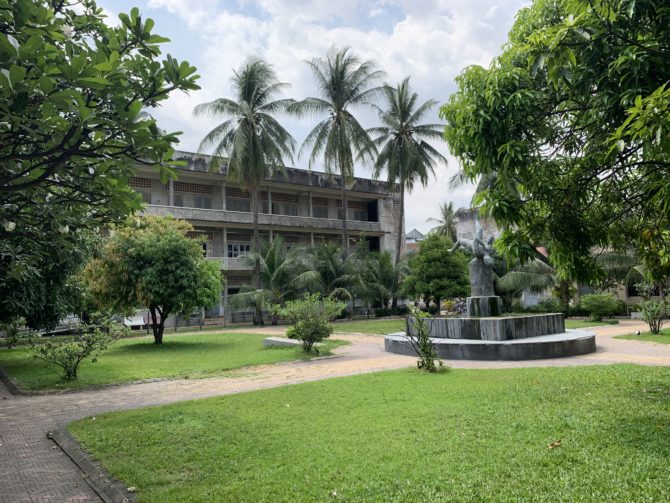
You can tell that it used to be a school. The buildings are long rectangular blocks, three storeys high, arranged around a central courtyard. The atmosphere is kept respectful by an audio guide, which most people chose to use, which means that people are walking around in silence as they listen. It’s exceptionally well done, with sensitive warnings so that you can skip the most brutal accounts of the torture itself, as I did. Just walking through the rooms has a nightmarish quality. I was more interested in learning about the background to the catastrophe, which I learnt a lot about from the audio guide and then continued to learn more that evening by starting to read a book about it (Pol Pol: The History of a Nightmare).
As is always the case with these modern, twentieth-century genocides it is the ‘bureaucracy of death’ which is the most chilling: the forms, the processes, the endless photos of prisoners wearing numbers for identification. I look at the photos and tried to pick out some individuality – who looks resigned, confused, frightened, defiant, powerless? But it didn’t matter; they were all killed just the same. What was unusual about the Khmer Rouge was their ideological extreme. This wasn’t ‘just’ a revolution, it was an attempt to completely eradicate the concept of the city and ‘return’ everyone to a fantasy agrarian state. Seen in that light, and with the photos of the bombed-out wreck of Phnom Penh in the 1970s, it made me appreciate this city’s modern existence all the more.
On the way back, our tuk tuk driver told us that he was going home to his village for Cambodian New Year. I asked if he was going to see family, but I think he said that they were all dead. It was difficult to make out what he was saying above the noise of the tuk tuk ride, and anywhere else I would have assumed that he must have actually said something else, but in Cambodia all this is recent memory. He went on to complain about the corrupt government in power today. And while there have been some trials, there is no clean slate – there never is, especially with civil wars – between the crimes of yesterday and the people in power now.

We spent most of the next day travelling from Phnom Penh to Siem Reap, the city which is the base for visiting the famous temples of Angkor. Angkor was the capital of the Khmer Empire between the 9th and 15th centuries and is now a huge, sprawling site of buildings and ruins. As I read more about Cambodia’s modern history, it’s clear that this sense of a ‘past greatness’ which was lost has been a huge and destructive influence, and this was reinforced by our visit to the Angkor National Museum. History is divided into the pre-Angkor, Angkor and post-Angkor periods and it is clear which one you are supposed to focus on, with dramatic background music accompanying sweeping videos of glorious temples like something out of a 1990s fantasy adventure movie. (And yes, there are many other countries which are obviously afflicted by the sense of a lost golden age, most definitely including Britain.)
In theory you are ‘supposed’ to spread your Angkor visit out over three days. But given the heat, we decided to pick one day to set our alarms for 4am, go see the sunrise at Angkor Wat and then enjoy whatever else came our way before we ran out of energy. Our tuk tuk driver, Thorn, was a friend of our AirBnb host and was amazing – picking us up in the dark and then driving us around five temples in total before we called it a day. So here is a short summary of what you might see if you visit Angkor. It’s most definitely not comprehensive, but did give us a good variety in the time we had.
Angkor Wat: The Big One


So this is the famous one, the one you’ve already heard of and came to Siem Reap to see in the first place. Originally a Hindu temple – and possibly also a mausoleum – it is now Buddhist and still an active place of worship, although the feeling inside is somewhere halfway between ‘in use’ and ‘abandoned’. I might call it ‘slumbering’. We watched the sunrise along with many other people and then climbed to the top of the central section of Angkor Wat; it’s such a huge structure that it didn’t really feel crowded despite all of the tourists. The walls are beautiful and decorated with huge bas reliefs of Indian epics.


Prasat Bayon: Indiana Jones Adventures


This was my favourite temple, and I’m not ashamed to put that down to the inescapably Indiana Jones vibe. Bayon, which lies in the middle of what was once the city of Angkor Thom, has a lot more of a ‘ruined’ vibe than Angkor Wat and feels more intimate to explore. Walking over wobbly bricks reminded me of a particularly well-made escape room, except of course this is real. The most striking parts are the giant faces which are built into the temple itself.


Prasat Baphuon: The Pyramid and the Portal
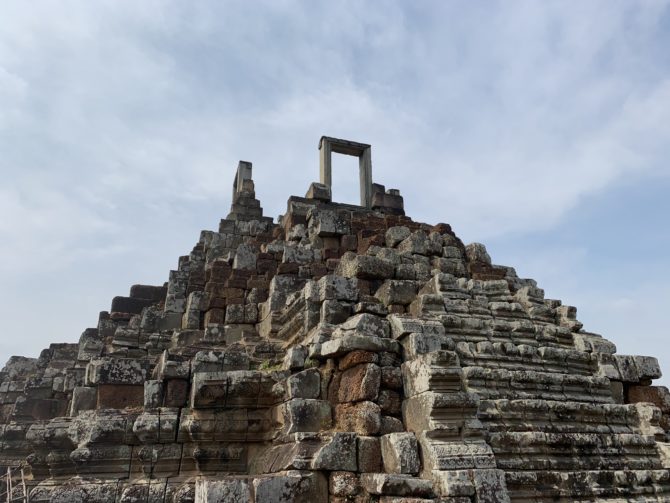
OK, so the archway at the top of Baphuon Temple is probably not actually a gateway to other worlds. But I would like to think so, especially since it took a couple of steep staircases to get up there in the first place and by this point in the day we were both starting to fade. Wisely, the Cambodian government does not allow you to actually reach the top and pass through the portal itself. (Look we didn’t pay for a tour guide so I can’t give you the full history of these temples. Although sometimes we did stand near to other groups and accidentally learn something.)


Ta Keo: Broken Chess Pieces
I was planning on calling this ‘The Boring Reconstructed One’ but that is overly harsh. Based on the before-and-after photos on the panel displays, however, the downside of restoring the structure (built entirely out of sandstone) is that it makes it somewhat less awe-inspiring to visit. I did like what looked like a box of giant broken chess pieces, though.


Ta Prohm: Collapse in a Forest
Finally, we reached Ta Prohm which is in the middle of a forest and presents a vision of the future where all the humans have died off and everything we ever built is slowly reclaimed by nature. According to Wikipedia, this is closest to the condition that almost all of the temples at Angkor fell into after the fall of the Khmer Empire, which must have been incredible when they were first rediscovered centuries later.



After our Angkor excursion I took an afternoon nap and woke up to discover that the power was out. Our AirBnb host confirmed that this was a city-wide problem (except for some parts of the tourist centre) caused by storms in Thailand and was expected to be fixed by 10pm that night, which it duly was. The disadvantage was that we lost our air-conditioning and fans for a few hours, but on the plus side it was pretty romantic and atmospheric at our candlelit dinner which our host very kindly offered to drive us to.
It is worth noting – and I have been looking for a place to shoehorn this in – that even in the middle of a power cut the 3G mobile data in Cambodia was not only working but still faster than much of the WiFi we used in South America. This has been true all over Southeast Asia and it really makes me wonder what is going on in South America to make the Internet so much slower.
The rest of our time in Siem Reap has been deliberately slow-paced. I had imagined a sleepy small town whose only existence was as a gateway to Angkor, but actually it is a fairly built-up city with a bustling tourist area downtown by the river. (It was here that we found a New Zealand bar serving real honest-to-god pies and mash, which might sound ill-suited to the weather but was amazing after so many months!)
Anyway, congratulations if you’ve made it through this epic post of civil war and ancient temples. It’s telling that of all the countries we’ve visited on our travels over the past five months it has been the extremes of Cambodia’s recent history which has driven me to pick up a book and go deeper into the history of the country, something which I will still be reading after we cross the border back into Thailand tomorrow. And in less than a week, I will be home!





So, wait, is it Ho Chi Minh City or Saigon? The answer, a little unsatisfyingly, is both. Obviously this is a political story, with Saigon being the capital of South Vietnam until its fall in 1975 and the reunification of the country. At that point Saigon was merged with the surrounding area and became Ho Chi Minh City for official purposes, but the name Saigon is far more commonly used around the actual city itself, including the railway station and all of the businesses. It’s also very unwieldy to say ‘Ho Chi Minh City’ out loud, plus there is a convention that the central part is still Saigon. So take your pick.
Whatever you call it, I think it’s undeniably less charming than Hanoi. The streets are wider, making the traffic that much more intense if you want to cross a road, and it’s very much the country’s commercial centre rather than the quieter, more government-focused capital up north. I will give it to them that bánh mì – their flagship street food – is considerably more appetising than phở. And that our hostel provided one free beer every night during happy hour – a good way to ready ourselves before heading out into the jungle of motorbikes for dinner.
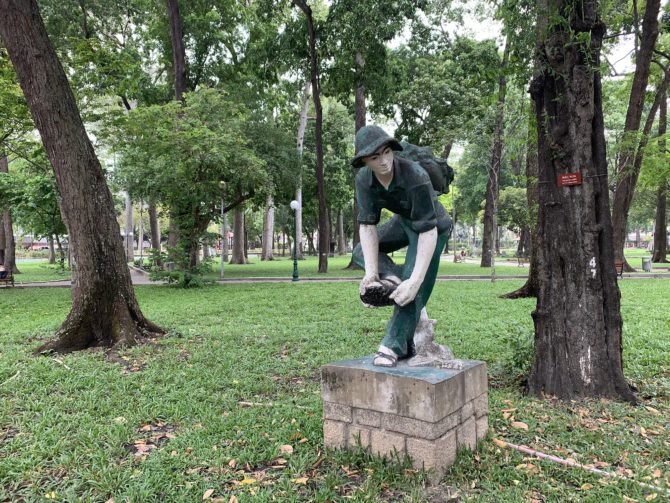
The only bona fide tourist attraction we visited in the city itself was the Independence Palace, former home to the President of South Vietnam. The explanatory text around the building was on the better side of the museums we have seen here, and relatively neutral and descriptive in its tone. Touring the rooms downstairs did feel a bit like scouting a potential conference venue, and I half-expected someone to appear to compare different seating arrangements. In the basement lies the presidential bunker, replete with lots of war maps on the walls, ancient communication technology and dark corridors from one of the N64 Goldeneye levels.

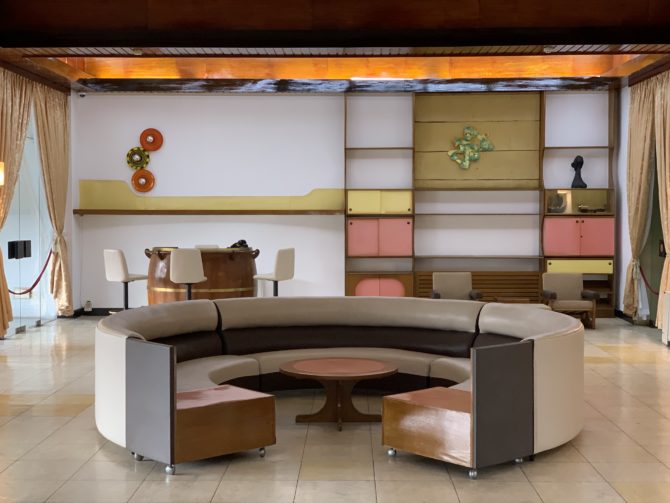


The number one thing to do here is to visit the Củ Chi tunnels, a giant underground network which lie a couple of hours’ drive outside the city and were a significant operational base for the Viet Cong during the Vietnam War. I was a little nervous about seeing these, as I had read that they have become touristy to the point of being distasteful to the memory of a war in which millions of people died not so long ago. There are two sites available for visits: Ben Dinh, which is closer, and Ben Duoc. To ease my fears about the trip we booked a small tour group to Ben Duoc on the basis that it is “less touristy”. I was a bit sceptical that this could really be true given that the advice to choose Ben Duoc is repeated all over the Internet, but in actual fact the blogs had it right this time and the site is still relatively quiet, uncrowded and respectful.
Our tour guide was a retired teacher who had been a reserve solider in the South Vietnamese army and was in love with English idioms, working them relentlessly into conversation (“sucker for a pretty face”, “it takes two to tango”, “really hard done by”) before repeating them quietly to himself under his breath for practice. He was cheerfully dismissive of the North Vietnamese “exaggerations” around the exhibit and wistful about the multi-party system in Vietnam which might have been. It was good to get a different perspective on the war from someone local. For balance, we were also shown a grainy propaganda film about the “crazy bunch of devils” (i.e. the Americans) who bombed the country relentlessly before being taken to the tunnels themselves.
Before visiting, I thought it was the height of absurdity that some of the tunnels have been widened for Western tourists. Having been there, I still think it’s absurd but I have accepted the fact that I would probably still be stuck in the original tunnels if they had not been. We bent over and near-crawled through several short sections of tunnels – stopping to see mannequin figures stand in for Viet Cong fighters in underground rooms – and my knees hurt even after these very brief explorations. It’s crazy to imagine what this network must have been like, before any electric lighting or paths cleared through the jungle, in the middle of a brutal guerrilla war.


I was less keen on the gleeful presentation of various gruesome booby traps. They are morbidly fascinating to see, of course, but it brought home the arbitrary unfairness of time and place that I was here on a tour group rather than a military draft. And I was very grateful that our guide completely vetoed a trip to the shooting range on the grounds that it was a rip-off, because I really don’t have any desire to fire a gun, even for fun.
Fun side-note: we smelled a little of baby food during this outing, after accidentally buying our mosquito spray from a children’s shop and ending up with weird-smelling protection which is apparently “ideal for the little ones”. It did seem to ward off the mosquitoes, though.
Tomorrow morning we will catch our bus out of Vietnam and into Cambodia for the last new country of our travels. Overall, Vietnam has surpassed my expectations and I really enjoyed the experience of travelling down the length of the country, although we have realised that there are plenty of other stops we could have chosen and – one day – we might repeat the route with a whole new itinerary. Ho Chi Minh City will likely not be included unless they manage to sort out their roads, though 😉














